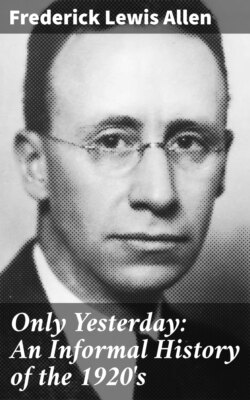Читать книгу Only Yesterday: An Informal History of the 1920's - Frederick Lewis Allen - Страница 23
На сайте Литреса книга снята с продажи.
[4]
ОглавлениеTable of Contents
By this time, too, a new game was beginning its conquest of the country. In the first year or two after the war, Joseph P. Babcock, Soochow representative of the Standard Oil Company, had become interested in the Chinese game of Mah Jong and had codified and simplified the rules for the use of Americans. Two brothers named White had introduced it to the English-speaking clubs of Shanghai, where it became popular. It was brought to the United States, and won such immediate favor that W. A. Hammond, a San Francisco lumber merchant, was encouraged to import sets on an ambitious scale. By September, 1922, he had already imported fifty thousand dollars' worth. A big campaign of advertising, with free lessons and exhibitions, pushed the game, and within the next year the Mah Jong craze had become so universal that Chinese makers of sets could no longer keep up with the demand and American manufacture was in full swing. By 1923, people who were beginning to take their radio sets for granted now simply left them turned on while they "broke the wall" and called "pung" or "chow" and wielded the Ming box and talked learnedly of bamboos, flowers, seasons, South Wind, and Red Dragon. The wealthy bought five-hundred-dollar sets; dozens of manufacturers leaped into the business; a Mah Jong League of America was formed; there was fierce debate as to what rules to play by, what system of scoring to use, and what constituted a "limit hand"; and the correct dinner party wound up with every one setting up ivory and bamboo tiles on green baize tables.
Even before Mah Jong reached its climax, however, Emil Coué had arrived in America, preceded by an efficient ballyhoo; in the early months of 1923 the little dried-up Frenchman from Nancy was suddenly the most-talked-of person in the country. Coué Institutes were established, and audiences who thronged to hear the master speak were hushed into awesome quiet as he repeated, himself, the formula which was already on everybody's lips: "Day by day in every way I am getting better and better." A few weeks later there was a new national thrill as the news of the finding of the tomb of King Tut-Ankh-Amen, cabled all the way from Egypt, overshadowed the news of the Radical trials and Ku Klux Klan scandals, and dress manufacturers began to plan for a season of Egyptian styles. Finally, the country presently found still a new obsession--in the form of a song: a phrase picked up from an Italian fruit-vender and used some time before this as a "gag-line" by Tad Dorgan, the cartoonist, was worked into verse, put to music which drew liberally from the "Hallelujah Chorus" and "I Dreamt That I Dwelt in Marble Halls" and "Aunt Dinah's Quilting Party," was tried out in a Long Island roadhouse, and then was brought to New York, where it quickly superseded "Mr. Gallagher and Mr. Shean" in popular acclaim. Before long "Yes, We Have No Bananas" had penetrated to the remotest farmhouse in the remotest county.
Though the super-patriots still raged and federal agents still pursued the nimble Communists and an avowed Socialist was still regarded with as much enthusiasm as a leper, and the Ku Klux Klan still grew, the Big Red Scare was dying. There were too many other things to think about.
Perhaps, though, there was still another reason for the passing of the Red Menace. Another Menace was endangering the land--and one which could not possibly be attributed to the machinations of Moscow. The younger generation was on the rampage, as we shall presently see.
